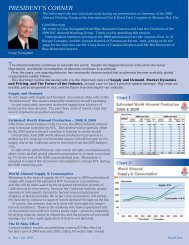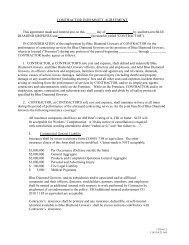View the PDF - Blue Diamond Growers
View the PDF - Blue Diamond Growers
View the PDF - Blue Diamond Growers
Create successful ePaper yourself
Turn your PDF publications into a flip-book with our unique Google optimized e-Paper software.
Time To ConsiderROB KISS, Field SupervisorBeesBees are still one of <strong>the</strong> majorexpenses on <strong>the</strong> production budget.Getting <strong>the</strong> most of <strong>the</strong> dollarinvested in bees is huge. One way toprotect your investment is for you,as a grower, to make a concertedeffort to check and record objectiveobservations of bee activity around<strong>the</strong> hive as soon as possible. Thetruth of <strong>the</strong> matter is that yourclose monitoring of hives starts assoon as <strong>the</strong>y are spotted in <strong>the</strong> field.Check your bees often; check<strong>the</strong>m early; check <strong>the</strong>m atdifferent times and underdifferent wea<strong>the</strong>r conditions.You should see significant activityaround each hive on sunny orwarming days. The <strong>the</strong>ory is thatbees fly at 55 degrees, and <strong>the</strong>ydon’t particularly like overcastor windy conditions. However,recently we have recorded fairlygood bee flights at temperaturescloser to 50 degrees. Remember,it’s too late if you recognize aproblem or particularly weak hiveswell into bloom. We only havea small window of opportunityfor pollination — we can’t blowit. If you do see any hives thatlook questionable, be sure tocommunicate with your beekeeperASAP; it’s your crop; it’s yourmoney.The following is a fairly establishedreview of guidelines growersshould keep in mind during <strong>the</strong>pollinations season.• Disperse <strong>the</strong> hives: Place<strong>the</strong>m in <strong>the</strong> sunniest locationsavoiding shade where possible,with hive entrances facingsouth, never north because itTIME TO CONSIDERis cooler. In larger blocks, hivescan be grouped at 500- to 1200-foot intervals and also through<strong>the</strong> centers. In smaller blocks (40acres or less), hives can be placedalong <strong>the</strong> perimeters, providingsecurity is not a factor.• Timing: They should be in <strong>the</strong>field at about popcorn of yourearliest blooming variety. Bloomsneaks up on us and placing <strong>the</strong>mafter <strong>the</strong> primary variety is inearly bloom may be late.• Maintenance: The beekeeperis responsible for making surecolonies are disease free andhave healthy queens. Beekeepersshould replace weak colonies assoon as possible.• Monitor: DO NOT assumeyour beekeeper will, as a matterof practice, come and monitoryour hives daily. Be sure to check<strong>the</strong>m, all of <strong>the</strong>m, every day anddocument hives that are inactive.• Access: Beekeepers need to havehive placement sites that are fairlyeasy to get to. They should have<strong>the</strong> right of entry to service <strong>the</strong>hives. Incidentally, it remains<strong>the</strong>ir responsibility to do so and<strong>the</strong> good beekeepers generallytake that responsibility seriously.• Pesticide Protection: Besure to communicate with yourbeekeeper about any applicationyou may make during bloom.The guidelines regarding beetolerance is on <strong>the</strong> label and <strong>the</strong>County Ag Commissioner canalso assist in details regardingmaterials registered for almondsand <strong>the</strong>ir effect on <strong>the</strong> bees.• Rental fee: There are obviouslya number of factors that influencethis. Availability, <strong>the</strong> cost ofproduction, hive maintenanceand transportation all go into <strong>the</strong>mix. Rental agreements with provisionsthat tie relative strength(frame count) to cost are becomingmore popular.• Payment schedule: Be sure todiscuss it and come to an agreementbefore placement. Termsmay include allowances forpoorly performing hives.42 Almond Facts NOVEMBER | DECEMBER 2012











